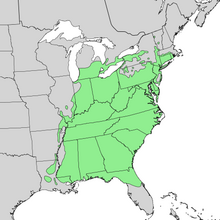
Back Tülpan ağacı Azerbaijani Tuliper de Virgínia Catalan Liriodendron tulipifera CEB Liliovník tulipánokvětý Czech Almindelig tulipantræ Danish Tulpenbaum German Tulipa liriodendro Esperanto Liriodendron tulipifera Spanish Idi-bihotz arbola Basque درخت لاله (گونه) Persian
| Liriodendron tulipifera | |
|---|---|

| |
| Liriodendron tulipifera cultivated at Laken Park in Belgium | |

| |
| L. tulipifera flower | |
| Scientific classification | |
| Kingdom: | Plantae |
| Clade: | Tracheophytes |
| Clade: | Angiosperms |
| Clade: | Magnoliids |
| Order: | Magnoliales |
| Family: | Magnoliaceae |
| Genus: | Liriodendron |
| Species: | L. tulipifera
|
| Binomial name | |
| Liriodendron tulipifera | |

| |
| Range | |
| Synonyms[2][3] | |
| |
Liriodendron tulipifera—known as the tulip tree,[a] American tulip tree, tulipwood, tuliptree, tulip poplar, whitewood, fiddletree, lynn-tree, hickory-poplar, and yellow-poplar—is the North American representative of the two-species genus Liriodendron (the other member is Liriodendron chinense), and the tallest eastern hardwood. It is native to eastern North America from Southern Ontario and possibly southern Quebec to Illinois eastward to southwestern Massachusetts and Rhode Island, and south to central Florida and Louisiana. It can grow to more than 50 m (160 ft) in virgin cove forests of the Appalachian Mountains, often with no limbs until it reaches 25–30 m (80–100 ft) in height, making it a very valuable timber tree. The tallest individual at the present time (2021) is one called the Fork Ridge Tulip Tree at a secret location in the Great Smoky Mountains of North Carolina. Repeated measurements by laser and tape-drop have shown it to be 191 feet 10 inches (58.47 m) in height.[4] This is the tallest known individual tree in eastern North America.
It is fast-growing, without the common problems of weak wood strength and short lifespan often seen in fast-growing species. April marks the start of the flowering period in the Southern United States (except as noted below); trees at the northern limit of cultivation begin to flower in June. The flowers are pale green or yellow (rarely white), with an orange band on the tepals; they yield large quantities of nectar. The tulip tree is the state tree of Indiana, Kentucky, and Tennessee.
- ^ Rivers, M.C. (2014). "Liriodendron tulipifera". IUCN Red List of Threatened Species. 2014: e.T194015A2294401. doi:10.2305/IUCN.UK.2014-3.RLTS.T194015A2294401.en. Retrieved 19 November 2021.
- ^ Tropicos
- ^ "The Plant List". The Plant List. 2012-03-23. Retrieved 2014-04-07.
- ^ Blozen, Will (April 29, 2011). "Fork Ridge Tulip Tree - New Eastern Height Record!!!". Archived from the original on May 7, 2023. Retrieved May 6, 2023.
Cite error: There are <ref group=lower-alpha> tags or {{efn}} templates on this page, but the references will not show without a {{reflist|group=lower-alpha}} template or {{notelist}} template (see the help page).
© MMXXIII Rich X Search. We shall prevail. All rights reserved. Rich X Search
